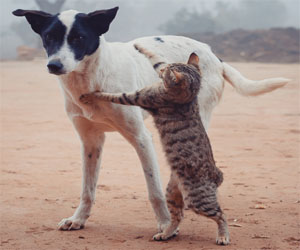


A Guide To A Safe And Happy Environment

Crate training is an effective and humane method for helping puppies become well-adjusted and well-behaved members of the family. While some may view crates as confinement, when used correctly, they provide a secure and comfortable space for your puppy. In this article, we will explore the benefits of crate training for puppies and provide guidance on how to implement it effectively.
Benefits Of Crate Training
Safety And Comfort: Crates offer a secure environment for your puppy, protecting them from household hazards, such as chewing on electrical cords or ingesting toxic substances. The crate can also serve as a cozy and familiar den where your pup feels safe and comfortable.
Housebreaking: Crates are valuable tools for housebreaking. Puppies instinctively avoid soiling their living area. By confining your pup to the crate when you cannot supervise them, you encourage them to "hold it" until they can be taken outside for bathroom breaks.
Preventing Destructive Behavior: Puppies can be quite mischievous, and unsupervised exploration can lead to destruction. Crate training helps prevent unwanted chewing or digging, thus protecting your belongings.
Travel And Vet Visits: Crate-trained puppies are more comfortable during car rides and vet visits. They are familiar with the crate and see it as a safe and comforting place, reducing stress during these experiences.
Steps For Effective Crate Training
Choose The Right Crate: Select an appropriately sized crate for your puppy. It should be large enough for them to stand, turn around, and lie down comfortably. However, it shouldn't be so big that they can use one end as a bathroom.
Introduce Gradually: Allow your puppy to explore the crate at their own pace. Start by leaving the crate door open, placing some treats or toys inside to encourage them to enter. Make the crate a positive and inviting space.
Feeding In The Crate: To create positive associations, feed your puppy inside the crate. Place their food bowl near the back, gradually moving it deeper into the crate over time.
Short Intervals: Begin by closing the crate door for short periods while you're present. Stay with your puppy and reassure them. Gradually increase the duration as your puppy becomes more comfortable.
Crate As A Bed: Encourage your puppy to nap inside the crate. Puppies need a lot of sleep, and associating the crate with rest is essential.
Regular Bathroom Breaks: When crate training for housebreaking, ensure that your puppy is taken outside for bathroom breaks at regular intervals. Praise and reward them when they eliminate outdoors.
Avoid Punishment: Never use the crate as a form of punishment. It should remain a positive and safe space for your puppy.
Gradual Expansion
As your puppy becomes more accustomed to the crate, you can gradually increase the time they spend inside when you're not around. Start with short trips out of the house and gradually extend the duration.
Crate training for puppies can be a valuable tool for promoting safety, housebreaking, and a sense of security. When done correctly, it provides your pup with a space where they can feel comfortable and protected. Be patient and consistent in your approach, and your puppy will learn to see the crate as a comforting den rather than a place of confinement. Ultimately, this training method contributes to a happy and well-behaved pup and a harmonious living environment for your entire family.
Unveiling The Enigmatic Connection

Hypnosis, a state of focused attention and heightened suggestibility, appears to provide a unique gateway to the subconscious mind. In this altered state of consciousness, individuals may be more receptive to suggestions and prompts from a skilled hypnotist, which can be harnessed to access and retrieve memories that are otherwise difficult to recall in a waking state.
One of the most compelling applications of hypnosis in memory retrieval is in the field of forensic psychology. Hypnotic regression, a technique used to guide individuals back to the time of an event they may have forgotten, has been employed to assist witnesses or victims in recalling critical details that can aid in criminal investigations. This technique has been instrumental in helping individuals remember faces, license plate numbers, or specific events that they might have forgotten or suppressed.
Embracing Sustainability And Environmental Responsibility
 2. Energy Efficiency
2. Energy Efficiency
Energy efficiency is a fundamental pillar of a clean energy future. It involves the optimization of energy use across various sectors, including residential, commercial, and industrial settings. Energy-efficient technologies, improved building designs, and sustainable practices reduce energy waste, lower energy bills, and cut greenhouse gas emissions.
3. Electrification Of Transportation
Transitioning from gasoline and diesel-powered vehicles to electric vehicles (EVs) plays a pivotal role in reducing carbon emissions. EVs produce zero tailpipe emissions, significantly lowering the carbon footprint of transportation. The expansion of EV charging infrastructure and the development of advanced battery technologies are driving this transformation.






Unleashing The Potential Of Man's Best Friend
 Agility competitions are among the most popular forms of canine performance. In these events, dogs must navigate through a challenging obstacle course, showcasing their speed, dexterity, and responsiveness to their owner's commands. The bond and coordination between the dog and owner are truly remarkable, as they work together to complete the course successfully.
Agility competitions are among the most popular forms of canine performance. In these events, dogs must navigate through a challenging obstacle course, showcasing their speed, dexterity, and responsiveness to their owner's commands. The bond and coordination between the dog and owner are truly remarkable, as they work together to complete the course successfully.
Obedience competitions focus on a dog's ability to follow commands and exhibit self-control. Dogs are evaluated based on their precision in executing commands like sitting, staying, heeling, and more. These competitions highlight not only the dog's obedience but also their intelligence and the dedication of their owners to training.
 One of the most prominent ways in which Nostradamus' prophecies have permeated popular culture is through literature and books. Numerous authors and researchers have delved into his writings to extract or reinterpret his predictions. They have written books analyzing Nostradamus' quatrains in relation to contemporary events, suggesting connections between his words and significant occurrences. This has led to a vast collection of literature exploring Nostradamus' purported insights.
One of the most prominent ways in which Nostradamus' prophecies have permeated popular culture is through literature and books. Numerous authors and researchers have delved into his writings to extract or reinterpret his predictions. They have written books analyzing Nostradamus' quatrains in relation to contemporary events, suggesting connections between his words and significant occurrences. This has led to a vast collection of literature exploring Nostradamus' purported insights.
In film and television, Nostradamus has been a source of inspiration for countless stories. He has appeared as a character or featured in plots that involve his predictions. Some productions have taken a more historically accurate approach, while others have embraced the mystique and portrayed Nostradamus as a true prophet with incredible foresight. His prophecies have been used as plot devices to create tension and suspense in various genres, from historical dramas to science fiction.
Nostradamus' influence extends to music as well. Many songs and albums reference his prophecies, symbolism, or ideas. Some artists have drawn inspiration from the mystique of Nostradamus' work to create lyrics and concepts that explore themes of prophecy, the future, and the unknown.
Additionally, Nostradamus' prophecies have found a place in video games and tabletop games. Game developers and creators have incorporated his quatrains as puzzles, challenges, or plot points, allowing players to interact with and explore the mysterious world of Nostradamus.
A Guide To Feline Well-Being
 2. Regular Veterinary Care
2. Regular Veterinary Care
Routine veterinary care is crucial for maintaining your cat's happiness. Regular check-ups and vaccinations are essential for preventing illness and ensuring your cat's well-being. Your veterinarian can also address any health issues and provide guidance on preventive care.
3. Emotional And Social Needs
Cats may be independent, but they are not solitary creatures. They require social interaction and affection. Spend quality time with your cat, petting and talking to them. Building a strong bond with your cat is a surefire way to enhance their happiness.
4. Mental Stimulation
Cats are curious creatures that need mental stimulation to be content. Provide them with toys, puzzles, and interactive playtime. Toys like feather wands, laser pointers, and treat-dispensing puzzles can keep your cat engaged and mentally active.
5. Grooming And Hygiene
Regular grooming is essential for your cat's well-being and happiness. Brush your cat to prevent matting and reduce shedding. Cats may also require occasional baths. Keeping their claws trimmed and providing scratching posts helps maintain their hygiene.
6. Safe Environment
Creating a safe environment is crucial for your cat's happiness. Remove hazards, keep toxic substances out of reach, and offer stimulating objects and areas for exploration. Cats enjoy window perches, scratching posts, and safe outdoor spaces if available.
A Call To Action For A Sustainable Future
 Understanding The Climate Crisis: The climate crisis, often referred to as global warming or climate change, stems from the excess emission of greenhouse gases into the Earth's atmosphere. These emissions, primarily from burning fossil fuels and deforestation, trap heat, leading to a rise in global temperatures. The consequences are far-reaching, including more frequent and severe droughts, storms, sea-level rise, and disruptions to ecosystems.
Understanding The Climate Crisis: The climate crisis, often referred to as global warming or climate change, stems from the excess emission of greenhouse gases into the Earth's atmosphere. These emissions, primarily from burning fossil fuels and deforestation, trap heat, leading to a rise in global temperatures. The consequences are far-reaching, including more frequent and severe droughts, storms, sea-level rise, and disruptions to ecosystems.
The Urgent Need For Action: The urgency of the climate crisis response cannot be overstated. Failure to address this crisis threatens the well-being of people, ecosystems, and economies worldwide. It also exacerbates global inequality and poses a significant risk to future generations.
Key Components Of Climate Crisis Response:
Mitigation: Mitigation strategies aim to reduce greenhouse gas emissions and slow down the rate of climate change. This involves transitioning to renewable energy sources, improving energy efficiency, and implementing policies to limit emissions from transportation, industry, and agriculture.
Adaptation: As the effects of climate change are already underway, adaptation is essential. It includes measures to protect communities from rising sea levels, extreme weather events, and changing climate patterns. Adaptation strategies may involve infrastructure improvements, flood defenses, and sustainable land management.
Renewable Energy: The transition from fossil fuels to clean, renewable energy sources is a cornerstone of the climate crisis response. Solar, wind, hydropower, and geothermal energy offer sustainable alternatives to coal and oil, significantly reducing carbon emissions.